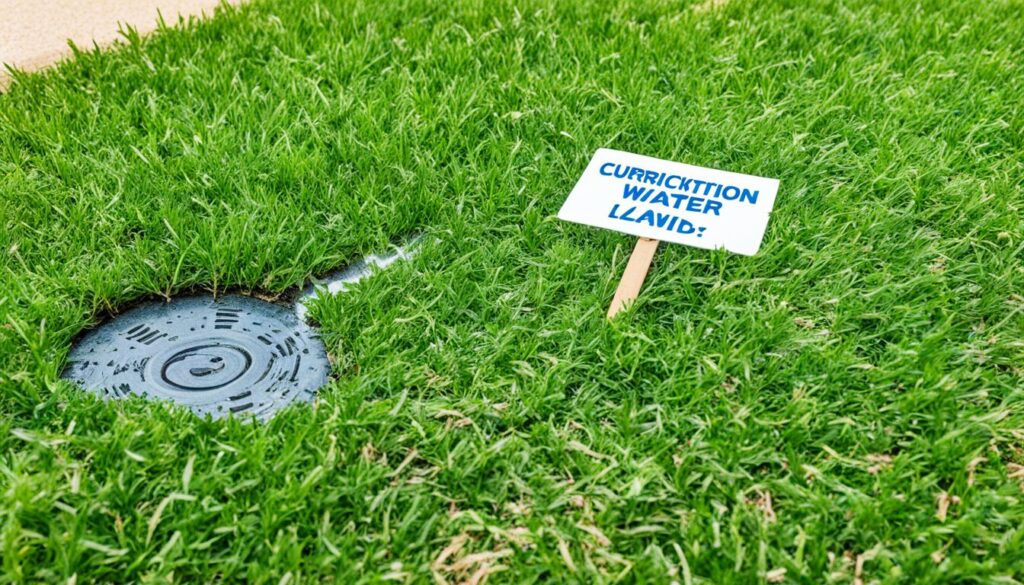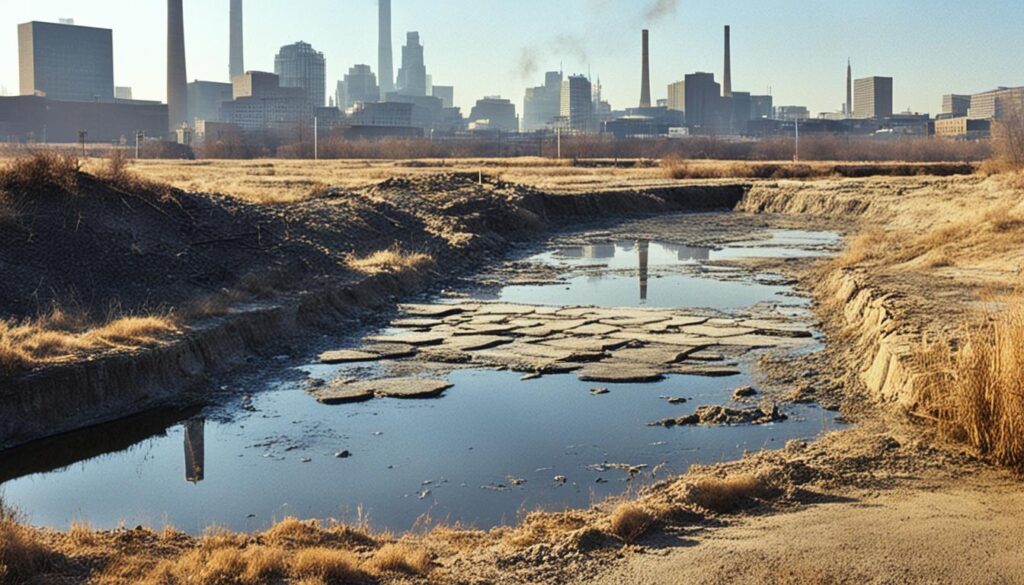Austin TX Water Restrictions – Current Rules & Info
Austin, Texas is facing Stage 2 Drought Water Use Restrictions. This is because of severe drought conditions in the Lower Colorado River Basin. This area has Lakes Travis and Buchanan, Austin’s main water sources. To help, the city limits watering to once a week for homes, businesses, apartments, and schools. They set specific watering days and times by address or property type.
By following these rules and using water smartly, big savings are possible. For example, using a hose-end sprinkler or an automatic system when it’s not peak hours helps a lot. People can save from 7,000 to 14,000 gallons of water each month. This could also mean saving up to $150 each month. But, if you don’t follow these rules, you might have to pay up to $1,000 for each time you break them.
There are some exceptions to these rules. If you apply for a variance, you might get an exemption based on your situation. This could be for setting up a new drought-friendly garden or if your business needs a lot of water.
Key Takeaways
- Stage 2 Drought Water Use Restrictions in Austin mandate watering only once a week.
- Residents can save between 7,000 to 14,000 gallons of water per month by adhering to the schedule.
- Households could save up to $150 monthly by reducing watering frequency.
- Violations of water restrictions may result in penalties up to $1,000 per violation.
- Exemptions through variance requests are available for specific justified circumstances.
Understanding Austin’s Current Water Restrictions
Austin is now under Stage 2 Drought Water Use Restrictions. This is because of the severe ongoing drought. The restrictions help control water use, keeping water levels in Lakes Travis and Buchanan stable. With expected higher temperatures, it’s key we all help save water.
Overview of Stage 2 Drought Water Use Restrictions
Stage 2 restrictions in Austin are tough, tougher than in other places. They set when and how much water we can use. Following these rules helps everyone save water.
Water use per person in Austin dropped from over 160 gallons daily in 2011 to about 130 gallons in 2022. Even with rain last May, our water supply lakes are still not full. It’s clear we need to keep up with these conservation efforts.
Watering Schedule for Residential Areas
For homes, the watering schedule is strict but necessary. If you use hose-end sprinklers, you can water twice a week during certain hours. Those with automatic systems can water once a week. This can save a lot of water every month.
Sticking to your watering days is very important for saving water. The schedule is set up to help everyone do their part in conserving water.
| Residential Watering Device | Allowed Days | Allowed Times |
|---|---|---|
| Hose-end sprinklers | Two days per week | Midnight to 10 a.m. or 7 p.m. to midnight |
| Automatic irrigation systems | One day per week | Midnight to 8 a.m. or 7 p.m. to midnight |
Watering Schedule for Commercial, Multi-family, and Public Schools
Businesses, apartments, and schools also have a set watering schedule. They use hose-end sprinklers once a week at specific times. Public schools water only on Mondays, using any system.
Following the austin watering schedule helps us manage water well and avoid fines. By working together, we make sure there’s enough water for the future.
The watering rules balance keeping green spaces healthy with the need to save water. By following these rules, we all help keep lake levels stable. This prepares us for tougher restrictions if water gets even lower.
In the end, sticking to these rules is key for managing our water wisely. When we all do our part, we help secure a water-rich future for Austin.
Compliance and Penalties
Ensuring adherence to the water conservation measures in Austin TX involves stringent penalties and thorough monitoring. Residents and businesses must be aware of and comply with these regulations to avoid substantial fines.

Prohibited Activities and Enforcement Actions
Several activities are prohibited to encourage water conservation. These include:
- Allowing water to run off into streets or neighboring properties
- Not fixing leaks in irrigation systems and other water fixtures
- Operating commercial pressure washing equipment that doesn’t meet efficiency standards
- Running patio misters outside of 4 p.m. to midnight for commercial properties
- Operating fountains that do not recirculate water
Failing to adhere to these restrictions can result in fines of up to $1,000 per violation. Additionally, wasting water by any means, such as through charity car washes, can also attract stringent penalties.
Reporting Violations
Community involvement is key to maintaining water conservation measures in Austin TX. Residents are encouraged to report any violations they observe. You can report Austin watering violations through the city’s 311 service, which provides a platform for residents to help uphold water conservation efforts.
| Violations | Penalties |
|---|---|
| Allowing water runoff | Up to $1,000 per day |
| Leaking irrigation systems | Up to $1,000 per day |
| Improper use of commercial equipment | Up to $1,000 per day |
| Misuse of patio misters or fountains | Up to $1,000 per day |
Variances and Exemptions
Variances from water restrictions are granted on a case-by-case basis. Requests for variances can be justified by:
- New xeriscape landscape installations
- Large properties that cannot be fully watered within the current schedule
- Environmental protection needs
- Health and safety concerns
- Business operations reliant on water usage
- Documented medical hardships or disabilities
- Tree disease or pest control
These variances must be appropriately justified and approved by the authorities, ensuring that even special circumstances adhere to the goal of conserving water.
The Importance of Water Conservation
Water conservation in Austin is very important, especially with Stage 2 watering rules in effect. These rules highlight the need to think about how our water use affects the environment. They also show how saving water can save money. Plus, when we all work together, we can make a big difference.

Environmental Impact
The way we use water in Austin really matters for the environment. Saving water helps keep the local ecosystems healthy. It also means less stress for water treatment places. With efforts like the Aquifer Storage and Recovery project, we’re planning to save lots of water for the future.
Austin’s lakes are very low right now, only about 43% full. Despite this, our hard work conserving water is making a difference.
Economic Benefits
There are big money benefits to saving water. Using less water means cheaper bills for everyone. Plus, the city spends less on treating and moving water around. Since 2011, people in Austin have started using less water. This helps our wallets and protects our economy from drought problems.
Community Efforts and Success Stories
Austin’s water saving success comes from everyone pitching in. Homeowners and businesses alike have cut down on how much water they use. Together, we’ve made a big impact on reaching our water-saving goals.
Our city plans carefully for the future, updating our water saving plans every five years. The Water Forward Task Force is on a mission. They’ve got big plans, even if some people think we’re not doing enough. But, we’re really making progress!
We’re on track to use water even more wisely by 2029. Fixing leaks is a big part of this plan. We also might have to follow stricter rules if there’s a bigger drought. It shows how important it is for everyone to stick to our water-saving habits.
Austin TX Water Restrictions and the Drought Contingency Plan
In Austin, the drought contingency plan sets the rules during dry times. It outlines different levels of watering limits. These rules get tougher as the water supply drops. Right now, Austin is in Stage 2 watering restrictions because reservoirs are about 42 percent full. These steps are key to saving water.

Austin’s drought contingency plan includes steps to save water all year. For example, watering with sprinklers is limited to once a week. This rule has helped cut water use a lot. Austin people used to use over 160 gallons a day in 2011. By 2022, they used about 130 gallons a day. The goal is to reduce this even more to 123 gallons by 2029.
Here is a comparative table detailing Austin’s water usage and restrictions:
| Year | Gallons per Capita per Day | Watering Restrictions |
|---|---|---|
| 2011 | 160+ | Stage 2 |
| 2022 | 130 | Stage 2 |
| 2029 Target | 123 | Permanent restrictions |
The lawn watering restrictions in Austin’s plan are strict. Homes use 63% of the water, and businesses use about 29%. Austin Water works hard to lower use in all areas. They have fines and other steps to make sure everyone follows the rules. If water levels fall to 600,000 acre-feet, we’ll move to Stage 3. That means even harsher limits and quick fines for breaking them.
Austin is planning for the future with the Water Forward Plan. It’s a 100-year idea to manage water better. The city is looking at ways to save water underground for later. This shows Austin is serious about being ready for dry times and caring for the environment.
Conclusion
Austin is a city that cares deeply about saving water. Lakes Travis and Buchanan are getting lower, showing the need for urgent action. With Travis at only 40% full and Buchanan at 51%, we must follow water rules carefully.
Austin has faced drought since 2008 but has managed well, never hitting Stage 3 restrictions. Thanks to smart planning and water rights, the city uses less water than it can access. An agreement made in 1999 ensures Austin has enough water through 2050.
In 2014, the city used about 137,500 acre-feet of water. This shows Austin’s water-saving efforts are working. The drought now is as bad as the one in the 1950s. With recent years bringing much less water, saving every drop helps Austin stay strong.
Everyone in Austin needs to help save water. The city has rules like watering schedules and fines for breaking them to help everyone do their part. Plans for saving water now and in the future show Austin is ready to face any challenge. These efforts make Austin a leader in fighting drought.







